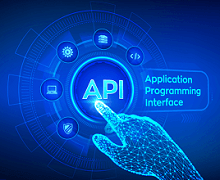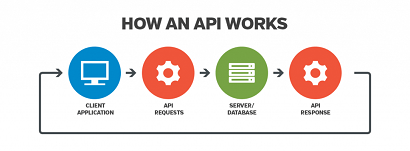API - Application Programming Interface
Today, we use mobile apps for almost all purposes. The purpose ranges from simply sending a message to checking cricket scores online. Application Programming Interface (API) is used to communicate between apps and to access and fetch the required information. What is an API?API is the abbreviation of the term Application Programming Interface. It is the software responsible for the connection for the communication and information exchange between two apps. API connects two devices or programs in order to facilitate the exchange of information between them. It is the interface that serves the other parts of the software. The API specifications are the standards or documents designed to describe the creation of such connections. If a computer system meets these standards, then it is said to expose an API. The specification or implementation both are known as the API. History of APIsThe concept of the API has been there since an early age. The implementation of API has seen various transformations over the years. The only difference has been the way in which the API was accessed and implemented. In the 1990s the Salesforce launched the web-based API that acted as the sales automation tool. It began the SaaS Revolution, which emphasised software as a service concept. The World Wide Web also encouraged the new way of delivering the software and built the infrastructure to accommodate the new system. The existence of the API can be traced even before the introduction of the World Wide Web and the Internet. It was first used to provide a service for a limited area. It connected the computer networks in that limited area. API has a bright future with users and programmers all over the world are using and creating apps that are hosted on the World Wide Web. The function of the API is to enable the API provider to expose the services. Therefore, the external systems call API providers and access the services. Web APIsWeb APIs provide services such as web notification and storage. These APIs can be accessed through the HTTP protocol. Different APIs differ in the level of security and privacy that they offer. It is possible to combine multiple web API to form a composite API. It is also known as a collection of data or service APIs. 
Types of Web APIThe various types of web APIs are as follows;
API Architectures and ProtocolsThere are specific rules for API calls, and these are defined by the API protocols. API protocol gives the accepted commands and data types according to the rules. The protocol constraints differ according to the API architecture. RESTREST is one of the most well-known API architectures. These are some of the principles that the API must adhere to, for being a REST API;
JSON-RPC and XML-RPCJSON-RPC and XML-RPC both use JSON and XML, respectively, to encode its call. RPC is also known as Remote Procedural Call Protocol. One result is expected from multiple parameters. Following are the features that differentiate it from the REST;
SOAPSOAP is also known as Simple Object Access Protocol. It is well-established and is intended to be extensible, neutral, and independent. Following are some of the specifications of the SOAP;
Although both are competing standards, it is possible to build RESTful API using SOAP protocols. The Evolution of the APIThe usefulness of the World Wide Web and its possibilities were well known at the beginning of the internet era. Hence, companies started transforming the method of providing products and services in a virtual store. Initially, SOA (Service Oriented Architecture) was the most popular model for the distributed systems. However, it had the limitations of the organisational boundaries. Later, tech experts realised the need to cross the organisational boundaries and hence soon they started publishing the data over the World Wide Web. Therefore, it no longer had any organisational boundaries. It unitised data from multiple sources and presented valuable insights before the customer. Example of an APIThe most common example of API is searching for information on the internet using an app. If you use an application for a particular purpose, you use the internet. A connection is established between the internet and the application. The internet provides data to the server; it retrieves data, processes the information, and sends it back to the phone. The task of the application is to interpret data and present it to the user in a readable format. This process is facilitated using API. The concept can be explained better with the help of an example. When you go to a restaurant and order food, the food comes from the kitchen. Hence the kitchen is the system. Your table is the place where the response is delivered. However, to deliver food on the table, there must be a channel of communication between the table and the kitchen. The waiter or API acts as a messenger between the table and the kitchen. It takes requests from you and tells the kitchen, which is a system, what has to be done. Then, the waiter delivers the response to the user, which is food in this case. Another real-life example of API is online flights booking. Similar to the previous example of a restaurant, there are many options of cities, return and departure dates, and cabin class. While booking a flight ticket, you select variables including the cabin class, departure city and date, and return city and date. All the options and data of the flights and the cost of the ticket are displayed on the airline website where you book the ticket. Therefore, you need to interact with the airline databases. However, suppose you use another travel service website that collects the data from various databases and presents it to the user. In that case, the travel service acts as the API of the airline. Like a waiter in the restaurant, the online travel service will provide options and aid in booking tickets. It does so by collecting the information from the databases. The API will collect the airline's response to your request, deliver it to an online travel service, and present it to you. In this way, you will be able to fetch the most updated information regarding your booking and flight. The data provided by API will be most relevant and helpful for the user. Therefore, the purpose served by the waiter in a restaurant is the same as that of the online travel service, and both of them are API. Hence, API is crucial for the communication between two systems. A layer of Security in APIWhenever we use an API, the server is not completely exposed to the device, neither the device is completely exposed to the server. The communication between them takes place through small packets of data that share only the necessary data. For example: While ordering food, you place your order that includes your requirements, and the restaurant puts forward their requirement. Hence you complete your order and get the meal delivered. APIs have become so useful that companies generate revenue using APIs. Some of the companies that make money using APIs are Amazon, eBay, Expedia, Google, and Salesforce.com. The APIs comprise a valuable part of the businesses by generating revenue for them. The marketplace of APIs is known as the 'API economy'. The Modern APIAPI has been described as a connectivity interface for an application. However, modern API has different characteristics that have made it more valuable. These are described below;
Use of API in Everyday LivesApplication Programming Interface (API) plays a crucial part in the economy. APIs are not easily noticed, but they are almost everywhere in our lives and affect us significantly. API is crucial in sharing data and aids communication between two individuals, apps or devices. Following are some of the common daily life functions of API.
The Future of APIsAPIs are necessary tools and have a bright future with the programmers developing new applications that increase users. The API providers play a crucial role in serving the API customers with event-driven APIs. Following are some predictions about the API economy and the development of API. Improved API experience on the mobile devicesThe network layer of TCP/IP protocol will face a complete revamp for better transformation packets under low and fluctuating network coverage. It is possible with the introduction of HTTP3. This will enable the app developers to improve their time to market as they can incorporate more APIs on the mobile apps. Therefore, the performance of the mobile applications will improve even if there is patchy coverage. It is because accessing APIs will become faster. New Business models around event-driven APIsThe API providers play a crucial role in serving the API customers with event-driven APIs. It means that there is a shift in the business logic from the API provider's end to the API customer. For example, while you book a ride on Uber, the app automatically assigns the drive and sends you the details. Hence, this is an event-driven API taking your decision behind the scenes, with the aim to serve you. Other expected development in the API field are;
Next TopicITI- Industrial Training Institute
|
 For Videos Join Our Youtube Channel: Join Now
For Videos Join Our Youtube Channel: Join Now
Feedback
- Send your Feedback to [email protected]
Help Others, Please Share










